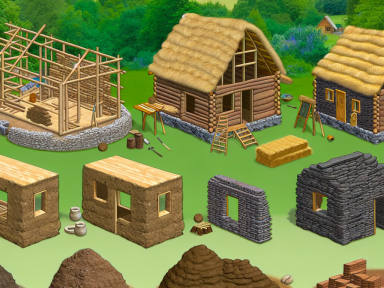Natural Building Techniques for Homesteaders
In a world where conventional construction relies heavily on costly materials and unsustainable practices, natural building techniques surge as not only cost-efficient but also environmentally responsible alternatives. For the self-reliant homesteader, mastering these methods isn’t just about building shelter; it’s about ensuring survival when modern resources may no longer be accessible or affordable.
Why Natural Building?
The fragility of our modern supply systems was highlighted by recent global crises, where disruptions caused significant shortages. By adopting natural building methods, you prepare to stand resilient in the face of such challenges, securing your family’s shelter independently.
Cob Building
One of the simplest yet profoundly durable natural building techniques is cob building. Cob is a mixture of clay, sand, straw, and water, hand-sculpted into walls. This method, used for thousands of years, provides excellent thermal mass, keeping interiors cool in summer and warm in winter, reducing reliance on energy-intensive heating and cooling systems.
- Cost-effective: Materials are often sourced directly from your land.
- High thermal properties: Natural insulation reduces energy needs.
- Non-toxic: Avoids the chemicals found in conventional building materials.
Straw Bale Construction
Another effective approach is straw bale construction, where bales of straw are used as structural elements or insulation. This technique not only provides exceptional insulation but also makes use of a by-product of grain production, which might otherwise go to waste.
- Superb insulation: Keeps your home insulated against extreme weather.
- Fire resistance: Contrary to assumptions, properly sealed straw bale walls have a high fire resistance rating.
- Flexibility in design: Allows for creative custom shapes and curves in building design.
Rammed Earth
Rammed earth, a technique involving compacting a mixture of natural materials like earth, clay, and gravel between formwork, creates walls with a striking aesthetic and robust durability. This method boasts millennia of validation, evidenced by ancient structures still standing today.
- Durability: Structures can last hundreds of years with minimal maintenance.
- Thermal mass: Natural regulation of temperature, reducing heating and cooling costs.
- Aesthetics: Natural textures and colors that blend seamlessly with natural surroundings.
Preparing for Challenges
The transition to using natural materials for building is not just about learning new techniques; it’s about preparing for a future where dependence on external resources could be a critical vulnerability. The knowledge and experience gained through building with natural materials enhance your autonomy and ensure resilience in uncertain times.
The vulnerability of not adopting natural building techniques stretches beyond simple readiness. It impacts your fundamental ability to provide safe, sustainable shelter independently. In an ever-changing world, possessing the capability to utilize the environment responsibly is not just valuable—it’s crucial.
Consider the move towards these natural building techniques not as a backup plan, but as an essential step towards future-proofing your homestead. Prepare now, build sustainably, and stand resilient against whatever challenges may come.




GIPHY App Key not set. Please check settings